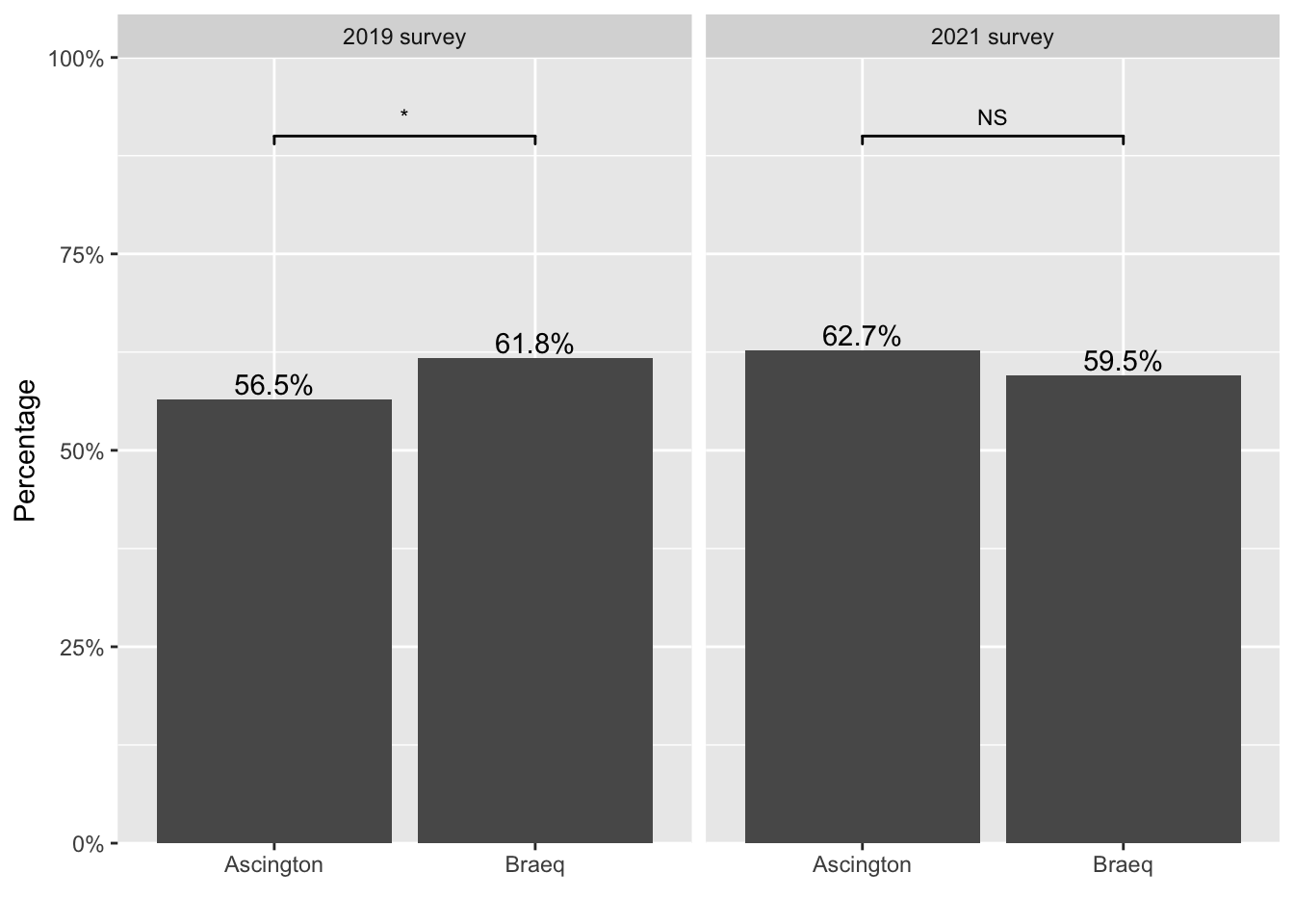Analyzing Survey Data
function purrr srvyr , updated 2023-05-21
This blog is the first one of a series that documents what I have learned at work while analyzing data from a few national surveys lately. Instead of using the actual survey data, I have simulated them to demonstrate the core problem while keeping the unnecessary details minimal.
Home ownership ¶
A household well-being survey was administered every couple of years in two provinces, Ascington and Braeq 1. One question on the survey was “Do you currently own or rent your home?” Figure 1 shows the results from the most recent two waves of the survey.
Starting from left panel, results based on the 2019 survey suggest that there were more home owners in Braeq than in Ascington. Moving on to the right panel, by 2021, the gap between the two provinces seemed to have disappeared, if not reversed.
This change is mainly driven by a growing number of home owners in Ascington over the past two years, and a slightly decreased percentage of home owners in Braeq during the same time period.
To understand how Figure 1 is created,
let’s first peak at the data underneath the figure.
If you want to follow along, run chunk 1 to access the demo data.
# chunk 1 (run this to access the demo data)
sim_survey <- dget("https://raw.githubusercontent.com/chunyunma/chunyunma-dot-me/main/static/txt/housing.txt")
chunk 2 reduces the original data into a contingency table
based on which Figure 1 was made.
# chunk 2
sim_survey_srvy <- sim_survey |>
srvyr::as_survey(weights = weight)
ownership <- sim_survey_srvy |>
dplyr::group_by(year, province, housing) |>
dplyr::summarize(perc = srvyr::survey_mean(),
freq = dplyr::n()) |>
dplyr::select(-perc_se)
owndership
# A tibble: 8 × 5
# Groups: year, province [4]
year province housing perc freq
<fct> <fct> <fct> <dbl> <int>
1 2019 ascington renter 0.435 535
2 2019 ascington owner 0.565 684
3 2019 braeq renter 0.382 482
4 2019 braeq owner 0.618 776
5 2021 ascington renter 0.373 480
6 2021 ascington owner 0.627 787
7 2021 braeq renter 0.405 506
8 2021 braeq owner 0.595 750
Now we are ready to plot.
step1 <- ggplot2::ggplot(
data = ownership,
ggplot2::aes(x = province, y = perc, fill = housing)) +
ggplot2::geom_col() +
ggplot2::facet_wrap(~ year)
The data underlying both panels in Figure 2 are identical. However, they look different. Figure 3 illustrates how to construct the final product from Figure 2 (left) step by step.
step2 <- ownership |>
dplyr::filter(housing == "owner") |>
ggplot2::ggplot(
ggplot2::aes(x = province, y = perc)) +
ggplot2::geom_col() +
ggplot2::facet_wrap(~ year)
step3 <- step2 +
ggplot2::scale_y_continuous(
labels = scales::percent_format(accuracy = 1),
limits = c(0, 1),
expand = c(0, 0)
)
step4 <- step3 +
ggplot2::scale_x_discrete(
labels = c(
"ascington" = "Ascington",
"braeq" = "Braeq")
)
step5 <- step4 +
ggplot2::labs(x = "", y = "Percentage")
survey_name <- ggplot2::as_labeller(c(
"2019" = "2019 survey",
"2021" = "2021 survey")
)
step6 <- step5 +
ggplot2::facet_wrap(~ year, labeller = survey_name)
step7 <- step6 +
ggplot2::geom_text(
ggplot2::aes(label = scales::percent(perc, accuracy = 0.1)),
position = ggplot2::position_dodge(width = 0.9), vjust = -0.25)
annotation_df <- sim_survey |>
dplyr::group_by(year) |>
tidyr::nest() |>
dplyr::mutate(model = purrr::map(
data,
function(data = data) {
srvyr::as_survey(.data = data, weights = weight) |>
srvyr::svychisq(formula = ~ province + housing)
}),
tidy = purrr::map(model, broom::tidy)
) |>
tidyr::unnest(tidy)
p_star <- function(p) {
symbol <- dplyr::case_when(
p <= 0.05 ~ "*",
TRUE ~ "NS")
return(symbol)
}
step8 <- step7 +
ggsignif::geom_signif(
data = annotation_df,
xmin = "ascington",
xmax = "braeq",
y_position = 0.9,
vjust = -0.2,
textsize = 3,
ggplot2::aes(annotations = p_star(p.value)),
manual = TRUE
)

To recap,
# contingency-table
ownership <- sim_survey_srvy |>
dplyr::group_by(year, province, housing) |>
dplyr::summarize(perc = srvyr::survey_mean(),
freq = dplyr::n()) |>
dplyr::select(-perc_se)
# chisq for annotation
annotation_df <- sim_survey |>
dplyr::group_by(year) |>
tidyr::nest() |>
dplyr::mutate(model = purrr::map(
data,
function(data = data) {
srvyr::as_survey(.data = data, weights = weight) |>
srvyr::svychisq(formula = ~ province + housing)
}),
tidy = purrr::map(model, broom::tidy)
) |>
tidyr::unnest(tidy)
# plot
ownership |>
dplyr::filter(housing == "owner") |>
ggplot2::ggplot(ggplot2::aes(x = province, y = perc)) +
ggplot2::geom_col() +
ggplot2::facet_wrap(~ year, labeller = survey_name) +
ggplot2::scale_x_discrete(
labels = c(
"ascington" = "Ascington",
"braeq" = "Braeq")
) +
ggplot2::scale_y_continuous(
labels = scales::percent_format(accuracy = 1),
limits = c(0, 1),
expand = c(0, 0)
) +
ggplot2::labs(x = "", y = "Percentage") +
ggplot2::geom_text(
ggplot2::aes(label = scales::percent(perc, accuracy = 0.1)),
position = ggplot2::position_dodge(width = 0.9), vjust = -0.25) +
ggsignif::geom_signif(
data = annotation_df,
xmin = "ascington",
xmax = "braeq",
y_position = 0.9,
vjust = -0.2,
textsize = 3,
ggplot2::aes(annotations = p_star(p.value)),
manual = TRUE
)
Scale up ¶
A typical household survey does not ask just one question. More likely several dozens of questions. Consider the following examples:
- Are you currently employed?
- Do you have any financial depedent?
- Do you have any debt?
All of these questions share the same binary structure
as the home ownership question we have seen before.
Presumably, we could re-use the code we have written for the housing variable
and create similar figures for new variables.
Or we could write some function!
-
factitious names generated using this website. ↩︎

